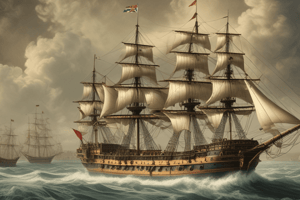Podcast
Questions and Answers
What was the age of British sea power?
What was the age of British sea power?
The 19th century.
Who defeated the French fleet at Trafalgar?
Who defeated the French fleet at Trafalgar?
Nelson.
What type of ships were built in the 19th century?
What type of ships were built in the 19th century?
Massive steam-powered iron clads.
What is the name of the ship mentioned in the text?
What is the name of the ship mentioned in the text?
Which country was the world's first industrial nation during this time?
Which country was the world's first industrial nation during this time?
What was the main reason for the British government allowing missionaries into India?
What was the main reason for the British government allowing missionaries into India?
What impact did the entry of missionaries have on Indian culture and religions?
What impact did the entry of missionaries have on Indian culture and religions?
What was the main duty of the East India Company after the removal of its trade monopoly?
What was the main duty of the East India Company after the removal of its trade monopoly?
How did the British view India during the Victorian era?
How did the British view India during the Victorian era?
What effect did the gap between British and Indians have on tolerance and willingness to learn about Indian culture?
What effect did the gap between British and Indians have on tolerance and willingness to learn about Indian culture?
Flashcards are hidden until you start studying
Study Notes
British Naval Power in the 19th Century
- The 19th century marked the peak of British sea power, bolstered by control of the seas.
- The Battle of Trafalgar in 1805, led by Admiral Nelson, was a decisive victory against the French fleet, solidifying British naval supremacy.
- The era transitioned from wooden ships to steam-powered ironclads, exemplified by HMS Warrior, which showcased unmatched strength and deterred enemy attacks.
Industrialization and Confidence
- Britain emerged as the world's first industrial nation, leading in innovation and technological advancements.
- National pride was encapsulated in the phrase "Britannia rules the waves," reflecting Britain's dominance on the global maritime stage.
The East India Company and British Control
- The East India Company's position faced challenges both domestically and in India, leading to the transfer of control to Queen Victoria.
- Public sentiment in England pushed for the "civilizing" of India, reflecting a paternalistic attitude towards Indian society.
Missionary Influence and Cultural Impact
- William Wilberforce championed abolition of the slave trade and advocated for the presence of missionaries in India.
- The 1813 act allowed missionaries into India, signaling an imperial challenge to Indian culture and religions.
- This act also dissolved the East India Company's trade monopoly, shifting its role to administering territories for the British crown.
Growing Cultural Divide
- British perceptions of India shifted to viewing it as "barbaric," exacerbating cultural tensions.
- The willingness to learn about Indian culture diminished, leading to increased alienation between British authorities and Indian society.
Studying That Suits You
Use AI to generate personalized quizzes and flashcards to suit your learning preferences.




